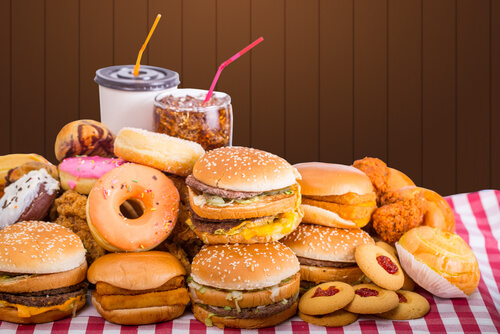
When people hear the word , it often calls to mind additions to alcohol or drugs. While these particular substance abuse disorders (drug and alcoholism) account for a significant percentage of struggles nationwide, there are several other behavioral challenges one may struggle with, which ultimately qualify as . People may struggle with s to technology, gambling, sex, shopping, exercise, and even eating. Although not the case for all of the above, some of these “other” s meet the criteria for listing and diagnosis in the Diagnostic and Statistical Manual of Mental Health Disorders, Fifth Edition (DSM-5).
In many cases, treatment for any of these specific s is available at treatment centers like Meadowglade. In the treatment setting, trained therapists can help you examine the root causes of addictive behavior, including fast food s, to help you develop better coping strategies and attain long-term recovery. If you are concerned about fast food , it is essential to reach out for help. Ongoing s to fast food can cause other physical and mental health effects, including significant weight gain, new or worsening heart conditions, new or worsening respiratory conditions, and challenges with your muscle or skeletal system due to potentially increased weight.
Fast food develops along a similar pattern to any other . The brain calls out for certain foods, and cravings for those foods begin. Perhaps you saw a commercial on television, or a familiar and enticing smell entered the car as you drove through town. Either way, these cravings can become overwhelming, leading us to consume foods that aren’t necessarily healthy or nutritious. Although the mind understands they are unhealthy, the rest of the brain ignores this knowledge and encourages you to order the donuts. While some people can manage such cravings or do not experience them to a significant degree, others cannot. In these casess such as fast food s develop.
How Fast Food Addictions Occur
The human brain operates on the reward system. When we do something good or something that encourages survival, the brain (and body) receives a reward. This includes primal behaviors such as eating. In some situations, such as substance , the actions of the drug or alcohol trick the brain into activating the reward system. This is how substance use disorders and substance s develop. In food, the brain knows when we are eating, and it knows eating is vital to survival. The brain is designed to release “feel good” chemicals into the body’s reward system when we do something good for ourselves.
These feel-good chemicals (also called neurotransmitters) include the chemical dopamine. The brain interprets dopamine as pleasure, and because the brain is wired to seek out behaviors that cause pleasure, it craves activities that trigger the reward system.
Unfortunately, modern fast food and junk foods can cause a reward for some people that is significantly more powerful than what the brain can achieve with whole foods. While eating chicken or a banana may trigger a moderate release of dopamine (because food is essential for survival or the food tastes good), eating a pint of Ben & Jerry’s or a box of Dunkin Donuts munchkins is significantly more rewarding and therefore triggers a larger release of dopamine. This disproportionate reward mechanism results in individuals who are susceptible to eating more unhealthy foods.
Fast Food Addiction and Withdrawal
Tolerance and withdrawal are often terms used when one reduces or stops using drugs or drinking. As the body tries to reacclimate to functioning without substances, Symptoms of withdrawal often occur. When someone does something repeatedly that releases dopamine into the body’s reward system (such as smoking, eating a Snickers bar, or grabbing a fast-food cheeseburger, the dopamine receptors can start to deregulate. Because the amount of dopamine in the body is so high when someone triggers their reward system consistently, the brain recognizes this. It begins removing dopamine receptors to try to balance your body. More dopamine is needed to reach the same “high” you previously experienced because there are fewer receptors. This causes you to eat more and more junk food to reach the same reward levels as before; this is called tolerance, and it is commonly seen in other addictive behaviors such as smoking and drinking. Unless you can get your “fix” of fast food, low levels of dopamine in your body will cause you to feel unhappy or even physically sick. This is indicative of early withdrawal.
How Cravings Impact Addiction
A craving is an emotional state characterized by the desire to do something. In the case of fast-food , that desire centers around procuring and eating food. Cravings are not to be confused with hunger, which is different and signifies your body’s natural reaction to requiring food to survive. Cravings can often occur at surprising and inconvenient times period; as previously noted, you might be watching television, going for a walk, or driving to the store when suddenly a craving occurs. Cravings can occur because of sensory stimuli such as seeing or smelling something. Cravings can also be induced due to specific emotional states, such as feeling depressed or lonely. This is known as emotional eating. Cravings are how the body satisfies the brain’s need for dopamine. The perceived need for food has little to do with the body’s need for energy, nourishment, or food required for survival. While cravings are not unusual or abnormal, repeatedly giving in to cravings and satisfying the desire for junk food is cause for concern.
Food Addictions Can Lead to Other Challenges
Food s can lead to other challenges, including mental and physical health difficulties. People who struggle with food satisfy the body’s reward system by eating a particular food until their brain achieves a particular level of dopamine. The more often you repeat this cycle of craving and reward, the more overwhelming cravings will become. Also, the quantity of food needed to satisfy the body’s reward system continues to increase. For example, one slice of pizza may be sufficient today. However, it may take three or four slices of pizza to satisfy your craving six or twelve months from now. It can be almost impossible to curb or satisfy cravings that are brought on due to . Ongoing eating at these levels can eventually lead to physical health disorders related to weight and mental health conditions such as disordered eating, depression, and anxiety.
At Meadowglade, our treatment programs can help you learn more about disordered eating and food s. Understanding these disorders can help you succeed in treatment and recovery. Many who struggled with food-related disorders do not realize they are also struggling with co-occurring mental health conditions. Seeking treatment for both disordered eating and mental health in a treatment setting equipped to treat co-occurring conditions will increase your opportunity for treatment success.
Treating and Overcoming Food Addiction
It can be challenging to prevent food s because food is essential to our survival. However, one of the best ways to avoid developing an to fast food is by ensuring you follow a healthy, balanced diet rich in natural, whole, and unprocessed foods. Eating a balanced diet and understanding possible fast food warning signs can help you act quickly and seed treatment if you suspect a problem. Without proper treatment, fast food s can quickly take over your life.
The process of overcoming fast food additions generally involves the same model used in treating other types of behavioral s. It is also essential to have a solid plan to overcome your and a reliable support system to turn to when experiencing triggers. The first step in overcoming fast food is to detox your body. This is done by avoiding triggering foods especially processed foods, fast foods, and foods that include excessive sugars. Early on, you may experience withdrawal symptoms that can range from mild to severe, depending on the severity of your . After you detox, you will need to begin the process of changing your eating behaviors. This step may require avoiding certain situations (triggers) and people that intensify your cravings. You may also need to break emotional and psychological connections between food and activities such as movies and popcorn or hot dogs and sporting events. Other helpful activities may include meal prepping and mindful eating.
For some struggling with a fast food , slow reduction and eventual recovery on their own is possible. For others who struggle with a more significant food , treatment to address your and other potential mental and physical health concerns may improve your opportunities for recovery. Once treatment is complete, some people can reintroduce small amounts of problem foods into their diets on rare occasions (such as a small slice of cake at a birthday party), but others must continue to avoid them indefinitely to ensure they maintain control over their health and recovery. Addiction is a highly individual and unique struggle. To best determine the long-term solutions for you, it is important to talk to your counselor about what the best and healthiest approach for you may be.
If you struggle with a fast food , your challenge may be more common than you realize. It is common for people to discuss s to drugs or alcohol, but other less understood s such as fast food do not receive as much attention as they should. Fast food , if left untreated, can be detrimental to your mental and physical health. Seeking treatment for and addressing any co-occurring physical or psychological struggles as part of a comprehensive, evidence-based, and holistic program enhances the probability for treatment success. If you struggle with a fast food , don’t wait another day to seek help. Contact us at Meadowglade today. Let our staff help you learn more about how a treatment program at Meadowglade can help you start on your journey to a healthy future.
Resources
https://pubmed.ncbi.nlm.nih.gov/21999689/
https://www.medicalnewstoday.com/articles/324847
